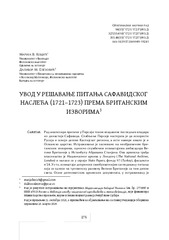Prikaz osnovnih podataka o dokumentu
Uvod u rešavanje pitanja Safavidskog nasleđa (1721-1723) - prema britanskim izvorima
Introduction to solving the issue of the Safavid heritage (1721-1723): According to British sources
| dc.creator | Kocić, Marija | |
| dc.creator | Elezović, Dalibor M. | |
| dc.date.accessioned | 2021-10-12T12:56:32Z | |
| dc.date.available | 2021-10-12T12:56:32Z | |
| dc.date.issued | 2019 | |
| dc.identifier.issn | 0354-3293 | |
| dc.identifier.uri | http://reff.f.bg.ac.rs/handle/123456789/2759 | |
| dc.description.abstract | Rad analizira prilike u Persiji tokom vladavine poslednjih vladara iz dinastije Safavida. Slabljenje Persije nastojala je da iskoristi Rusija i osvoji delove Kaspijskog regiona, a iste namere imalo je i Osmansko carstvo. Istraživanje je zasnovano na neobjavljenim britanskim izvorima, odnosno službenim izveštajima ambasadora Velike Britanije u Istanbulu Abrahama Stanjana. Ova arhivska građa vlasništvo je Nacionalnog arhiva u Londonu (The National Archives, London)i nalazi se u seriji State Papers, fondu 97 (Turkey), fascikli n°24. Uz to, izveštaji doprinose sveobuhvatnijem sagledavanju pitanja koja se odnose na trgovinsku razmenu Velike Britanije sa tim delom sveta. Osim diplomatskih arhivskih dokumenata, u istraživanju je kao izvor korišćena i ondašnja štampa (The Monthly Mercury), kao i rezultati savremene istoriografije, prvenstveno britanske i ruske. | sr |
| dc.description.abstract | The crisis which at the beginning of the 18th century caught Persia strengthened the aspirations of its neighbors, Russia and the Ottoman Empire, in regard to certain parts of its territory. The ascent of Persia in the era of Safavid contributed to the production of raw silk, which made it a major exporter of raw and processed silks of the finest quality. This was the main reason why some European countries (England, France and the Netherlands) established permanent diplomatic and trade relations with Persia. With several decades of delay, a new competitor appeared in that field, Russia, which in the middle of the 17th century was seriously interested in joining this trade, but by its own model. The British East India Company, which opened the factories in the most important centers of silk production, established by the benefits it gained a certain degree of monopoly on its exports directly from the territory of Persia. Although in certain periods the Porte was leading a protectionist policy to ban the export of Persian Silk through its territories, it did not succeed in it precisely because of the demand of the European market for the merchandise. Silk and raw yarn exported from Persia to the Ottoman Empire became the object of the trade of European Levant companies (English, French, and Dutch). The interests which the European trading companies placed in the course of events in the Ottoman Empire and in Persia took on the mark of serious diplomatic activities, which used various means to achieve political pressure. The initial phase of the disintegration of the Safavid state found its place in British diplomatic sources. The significance of these archival sources can be seen in the fact that they offer a different point of view it shows the realities in Persia in the period from 1721 to 1723, while presenting plenty of new data. The British diplomatic mission in the Ottoman Empire, led by Ambassador Abraham Stanyan, had a series of justifications to monitor developments in the Caspian and Caucasus regions, fearing that they would influence the fall of the British exchange with those areas. Due to the ambitions of Russia to divert to its territory parts of the trade route where the exchange of silk took place, the Levant Company would have become the most damaged side, which additionally influenced Stanyan to engage in the defense of British trade interests. Diplomacy, as a rule, played a role in normalizing relations in Persia, but its mechanisms of pressure, which it employed, proved insufficiently strong to prevent the Russian army from attacking Dagestan and Georgia, as well as the breakthrough of the Ottoman army in Persia. Attempting to neutralize the actions of French Ambassador Marquise de Bonacca, Stanyan sought to closely monitor developments in Persia and respond in a timely manner. In doing so, he was aided by the privileged position in the diplomatic corps in Istanbul, which British diplomats gained in successful mediation during the negotiations in Sremski Karlovci in 1699 and Požarevac in 1718, which was contrary to the principles of Russian diplomacy, which did not trust the Great Britain and its representatives in the Ottoman state and Persia. | en |
| dc.publisher | Univerzitet u Prištini - Filozofski fakultet, Kosovska Mitrovica | |
| dc.relation | info:eu-repo/grantAgreement/MESTD/Basic Research (BR or ON)/177009/RS// | |
| dc.relation | info:eu-repo/grantAgreement/MESTD/Integrated and Interdisciplinary Research (IIR or III)/47023/RS// | |
| dc.rights | openAccess | |
| dc.rights.uri | https://creativecommons.org/licenses/by-nc/4.0/ | |
| dc.source | Zbornik radova Filozofskog fakulteta u Prištini | |
| dc.subject | Velika Britanija | sr |
| dc.subject | trgovina | sr |
| dc.subject | Safavidi | sr |
| dc.subject | Ruska Imperija | sr |
| dc.subject | Persija | sr |
| dc.subject | Osmansko carstvo | sr |
| dc.subject | Safavid dynasty | en |
| dc.subject | Russia | en |
| dc.subject | Persia | en |
| dc.subject | Ottoman Empire | en |
| dc.subject | Great Britain | en |
| dc.subject | commerce | en |
| dc.title | Uvod u rešavanje pitanja Safavidskog nasleđa (1721-1723) - prema britanskim izvorima | sr |
| dc.title | Introduction to solving the issue of the Safavid heritage (1721-1723): According to British sources | en |
| dc.type | article | |
| dc.rights.license | BY-NC | |
| dc.citation.epage | 205 | |
| dc.citation.issue | 1 | |
| dc.citation.other | 49(1): 175-205 | |
| dc.citation.rank | M24 | |
| dc.citation.spage | 175 | |
| dc.citation.volume | 49 | |
| dc.identifier.doi | 10.5937/ZRFFP49-19241 | |
| dc.identifier.fulltext | http://reff.f.bg.ac.rs/bitstream/id/1440/2756.pdf | |
| dc.type.version | publishedVersion |

